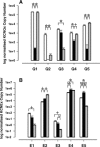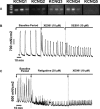The contribution of Kv7 channels to pregnant mouse and human myometrial contractility
- PMID: 20132415
- PMCID: PMC3922379
- DOI: 10.1111/j.1582-4934.2010.01021.x
The contribution of Kv7 channels to pregnant mouse and human myometrial contractility
Abstract
Premature birth accounts for approximately 75% of neonatal mortality and morbidity in the developed world. Despite this, methods for identifying and treating women at risk of preterm labour are limited and many women still present in preterm labour requiring tocolytic therapy to suppress uterine contractility. The aim of this study was to assess the utility of Kv7 channel activators as potential uterine smooth muscle (myometrium) relaxants in tissues from pregnant mice and women. Myometrium was obtained from early and late pregnant mice and from lipopolysaccharide (LPS)-injected mice (day 15 of gestation; model of infection in pregnancy). Human myometrium was obtained at the time of Caesarean section from women at term (38-41 weeks). RT-PCR/qRT-PCR detected KCNQ and KCNE expression in mouse and human myometrium. In mice, there was a global suppression of all KCNQ isoforms, except KCNQ3, in early pregnancy (n= 6, P < 0.001 versus late pregnant); expression subsequently increased in late pregnancy (n= 6). KCNE isoforms were also gestationally regulated (P < 0.05). KCNQ and KCNE isoform expression was slightly down-regulated in myometrium from LPS-treated-mice versus controls (P < 0.05, n= 3-4). XE991 (10 μM, Kv7 inhibitor) significantly increased spontaneous myometrial contractions in vitro in both human and mouse myometrial tissues (P < 0.05) and retigabine/flupirtine (20 μM, Kv7 channel activators) caused profound myometrial relaxation (P < 0.05). In summary, Kv7 activators suppressed myometrial contraction and KCNQ gene expression was sustained throughout gestation, particularly at term. Consequently, activation of the encoded channels represents a novel mechanism for treatment of preterm labour.
© 2011 The Authors Journal of Cellular and Molecular Medicine © 2011 Foundation for Cellular and Molecular Medicine/Blackwell Publishing Ltd.
Figures






Similar articles
-
Bimodal effects of the Kv7 channel activator retigabine on vascular K+ currents.Br J Pharmacol. 2008 Sep;155(1):62-72. doi: 10.1038/bjp.2008.231. Epub 2008 Jun 9. Br J Pharmacol. 2008. PMID: 18536747 Free PMC article.
-
Expression and function of K(v)7 channels in murine myometrium throughout oestrous cycle.Pflugers Arch. 2009 Mar;457(5):1111-20. doi: 10.1007/s00424-008-0567-5. Epub 2008 Aug 16. Pflugers Arch. 2009. PMID: 18709386
-
Loss of functional K+ channels encoded by ether-à-go-go-related genes in mouse myometrium prior to labour onset.J Physiol. 2009 May 15;587(Pt 10):2313-26. doi: 10.1113/jphysiol.2009.171272. Epub 2009 Mar 30. J Physiol. 2009. PMID: 19332483 Free PMC article.
-
Kv7 and Kv11 channels in myometrial regulation.Exp Physiol. 2014 Mar;99(3):503-9. doi: 10.1113/expphysiol.2013.075754. Epub 2013 Oct 11. Exp Physiol. 2014. PMID: 24121285 Free PMC article. Review.
-
The therapeutic potential of neuronal KCNQ channel modulators.Expert Opin Ther Targets. 2003 Dec;7(6):737-48. doi: 10.1517/14728222.7.6.737. Expert Opin Ther Targets. 2003. PMID: 14640909 Review.
Cited by
-
One man's side effect is another man's therapeutic opportunity: targeting Kv7 channels in smooth muscle disorders.Br J Pharmacol. 2013 Jan;168(1):19-27. doi: 10.1111/j.1476-5381.2012.02133.x. Br J Pharmacol. 2013. PMID: 22880633 Free PMC article. Review.
-
KCNE4 and KCNE5: K(+) channel regulation and cardiac arrhythmogenesis.Gene. 2016 Nov 30;593(2):249-60. doi: 10.1016/j.gene.2016.07.069. Epub 2016 Jul 30. Gene. 2016. PMID: 27484720 Free PMC article. Review.
-
Vasorelaxant effects of novel Kv 7.4 channel enhancers ML213 and NS15370.Br J Pharmacol. 2014 Oct;171(19):4413-24. doi: 10.1111/bph.12805. Epub 2014 Aug 14. Br J Pharmacol. 2014. PMID: 24909207 Free PMC article.
-
KV7 channels regulate muscle tone and nonadrenergic noncholinergic relaxation of the rat gastric fundus.Pharmacol Res. 2011 Oct;64(4):397-409. doi: 10.1016/j.phrs.2011.06.016. Epub 2011 Jun 28. Pharmacol Res. 2011. PMID: 21740972 Free PMC article.
-
Uterus-targeted liposomes for preterm labor management: studies in pregnant mice.Sci Rep. 2016 Oct 11;6:34710. doi: 10.1038/srep34710. Sci Rep. 2016. PMID: 27725717 Free PMC article.
References
-
- Steer P. The epidemiology of preterm labour. BJOG. 2005;112:1–3. - PubMed
-
- Mangham LJ, Petrou S, Doyle LW, et al. The cost of preterm birth throughout childhood in England and Wales. Pediatrics. 2009;123:e312–27. - PubMed
-
- Russell RB, Green NS, Steiner CA, et al. Cost of hospitalization for preterm and low birth weight infants in the United States. Pediatrics. 2007;120:e1–9. - PubMed
-
- Gyetvai K, Hannah ME, Hodnett ED, et al. Tocolytics for preterm labor: a systematic review. Obstet Gynecol. 1999;94:869–77. - PubMed
-
- Parkington HC, Tonta MA, Brennecke SP, et al. Contractile activity, membrane potential, and cytoplasmic calcium in human uterine smooth muscle in the third trimester of pregnancy and during labor. Am J Obstet Gynecol. 1999;181:1445–51. - PubMed
Publication types
MeSH terms
Substances
Grants and funding
LinkOut - more resources
Full Text Sources

